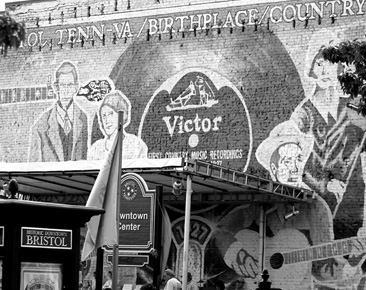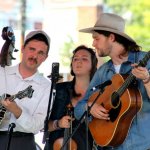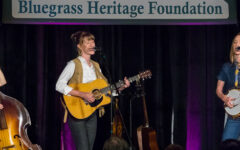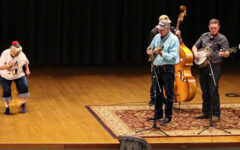
 With the generous support of Virginia Tech’s Department of Religion and Culture, Bristol Rhythm and Roots Reunion organizers, and the new Birthplace of Country Music Museum, nearly twenty students from VT were able to attend Bristol Rhythm and Roots Reunion for a day and tour the museum; for many it was their very first festival experience.
With the generous support of Virginia Tech’s Department of Religion and Culture, Bristol Rhythm and Roots Reunion organizers, and the new Birthplace of Country Music Museum, nearly twenty students from VT were able to attend Bristol Rhythm and Roots Reunion for a day and tour the museum; for many it was their very first festival experience.
I attended BR&RR as an instructor and group co-coordinator. While I do not remember my first festival (my mother believes I was not yet a year old when I had the pleasure), being able to stand alongside students viewing a live bluegrass performance reminded me of the “mystical power” of festivals that Carlton Haney so often spoke of—the vibrations of excitement that move from the instrument through the crowd in these special venues. While Bristol Rhythm and Roots is not a completely (typically traditional) bluegrass festival, it did allow students to observe the setting which is rooted in the traditions of early multi-day festivals such as Camp Springs and Union Grove.
Bristol Rhythm and Roots officially began in 2001 with a crowd of a few thousand. It has grown to crowds over 50,000. The festival’s collaboration with the Birthplace of Country Music Alliance came to full fruition this past year as the Birthplace of Country Music Museum (a Smithsonian affiliate) opened to the public.
The museum was a highlight of the trip for many. It provided a foundation for the festivities students immersed themselves in after the tour. With a special exhibit on the Carter family, students were able to see the direct linkage between the Bristol Sessions and current country music scene. As one student, Erika, reflected after the tour:
The music of Appalachia provides insight into the rich culture of the region, as well as the values and trials of the Appalachian people through time. The songs on the 1927 Bristol Sessions are snapshots of people’s lives and ways of living. They are ballads of the common man and they evoke the sentiments of the time. The bond of family, the struggles of the laborer, the power of community, the heartache of a lover, the glory of God, the suffering of the disenfranchised… For the people of the time, the songs themselves provided a means of interaction, inclusion, solidarity, expression, and relief from daily struggles. For listeners today, the songs of the country music pioneers provide a platform from which we can draw inspiration. The songs remain timeless because they have the ability to transcend time, allowing the stories, values, and struggles of people then and people now to resonate throughout history.
 Our class was able to attend the festival on Saturday, making Jeff Tweedy the headlining act. Tweedy, not-so-distant from bluegrass as an alternative country star, was famous with our group through his Wilco days and work with Billy Bragg more so than his Uncle Tupelo collaborations. His current band, which we saw, includes his son on the drums and students mentioned it echoed a familial tradition, even while his sound was not one we typically think of as “Appalachian.” Another headliner of the night was the Gospel-esque crooning of St. Paul and the Broken Bones from Alabama. Ray Wylie Hubbard, Texas country singer and songwriter was on the “must see” list of many students, however very limited seating at his indoor show left students looking elsewhere.
Our class was able to attend the festival on Saturday, making Jeff Tweedy the headlining act. Tweedy, not-so-distant from bluegrass as an alternative country star, was famous with our group through his Wilco days and work with Billy Bragg more so than his Uncle Tupelo collaborations. His current band, which we saw, includes his son on the drums and students mentioned it echoed a familial tradition, even while his sound was not one we typically think of as “Appalachian.” Another headliner of the night was the Gospel-esque crooning of St. Paul and the Broken Bones from Alabama. Ray Wylie Hubbard, Texas country singer and songwriter was on the “must see” list of many students, however very limited seating at his indoor show left students looking elsewhere.
The Black Lillies, an alt-country group with heart wrenching lyrics were stars of the evening. Another student favorite was the traditional bluegrass band Breaking Grass which opened for Balsam Range. Breaking Grass also played a packed indoor show. Courtney (a VT student) wrote;
From the drums, to the pianos, to the guitars, banjos, fiddles, and cellos the music of Appalachia kept me on the edge of my seat the entire time. Breaking Grass was one of the bands I thoroughly enjoyed listening to. They sang songs about growing up in the Appalachia’s [sic] and about the “good ol’ days”. Every band and song told a story. It told us about the past and the hard times faced by people, but how family always prevailed in the end.
 Other traditional groups included the family band, Flatt Lonesome; the aforementioned, Balsam Range; Donna Ulisse & the Poor Mountain Boys; the all-female band, After Jack; and the Australian bluegrass group, Mustered Courage. Old time bands were also taken in by students, most notably Jerron “Blind Boy” Paxton; the (local to Blacksburg, Virginia) old time group, Indian Run Stringband; and – if you found a space in the crowd — Amythyst Kiah Phillips.
Other traditional groups included the family band, Flatt Lonesome; the aforementioned, Balsam Range; Donna Ulisse & the Poor Mountain Boys; the all-female band, After Jack; and the Australian bluegrass group, Mustered Courage. Old time bands were also taken in by students, most notably Jerron “Blind Boy” Paxton; the (local to Blacksburg, Virginia) old time group, Indian Run Stringband; and – if you found a space in the crowd — Amythyst Kiah Phillips.
For many, favorite groups were outside the domain of typically traditional bluegrass; the Honey Island Swamp Band, The Giving Tree Band, and Annabelle’s Curse come to mind. Jarekus Singleton was also a noteworthy edition to the festival with his fantastic, foot-tapping blues showcase. This list is in no way inclusive of all the varying acts found on the Tennessee, Virginia line on Saturday, however they are the groups which stood out to the class.
You can stand in two states, eat the best of festival food, or sit in a local diner, take in a great blues show, bluegrass set, and rock out with St. Paul and the Broken Bones in a few hours. But why take a class? How is this a classroom?
 I was prompted to take the Introduction to Appalachian Studies class to live shows after hearing numerous students echo a similar sentiment: the class made sense after they saw live music and visited a live music venue. Once the atmosphere—everything from the food to the dance floor—was experienced, it became easier for students to relate to the readings. Further, as Appalachian Studies students we have a charge to find out what is around us—including our soundscape. Bristol, being only two hours from campus, was the ideal place for students to experience live music. We entered the festival with the following questions:
I was prompted to take the Introduction to Appalachian Studies class to live shows after hearing numerous students echo a similar sentiment: the class made sense after they saw live music and visited a live music venue. Once the atmosphere—everything from the food to the dance floor—was experienced, it became easier for students to relate to the readings. Further, as Appalachian Studies students we have a charge to find out what is around us—including our soundscape. Bristol, being only two hours from campus, was the ideal place for students to experience live music. We entered the festival with the following questions:
- How did venue spaces alter your experience? Do you prefer indoors or outside? Did you find the listening experience and the audience response different in these places? If so, how?
- Did your perceptions of bluegrass music and fans change after attending BR&RR? If so, how and why?
- Try to identify the genres that the festival includes in the “roots” music of the region. Do you hear Old Time? Bluegrass? Country? Rock? Blues? Hip Hop? Punk? Salsa? Zydeco? What do you think about the range of music(s) available? Do the genres fully represent the traditions and demographics of the region’s past and present?
- Bristol was a significant railroad town and now is a part of the Tri-Cities MSA (Metropolitan Statistical Area) right on Interstate 81, a crossroads for the region. What does it do to have an urban setting for a roots music festival? Do you think it changes the experience or meanings of the music?
- Pay attention to the ways in which different performers present themselves on stage. How are they signaling identity? What are they wearing? Do they mention place names? Do they mention particular teachers, mentors, or influences? What stories do they tell to place the music into what contexts?
 Once we arrived, students were able to spend time touring the museum before eating lunch together. We then reminded one another of the questions (above) directing our exercise in participant observation and students were allowed to attend the shows that most interested them, browse the vendors, or try the festival food.
Once we arrived, students were able to spend time touring the museum before eating lunch together. We then reminded one another of the questions (above) directing our exercise in participant observation and students were allowed to attend the shows that most interested them, browse the vendors, or try the festival food.
One student, Robert, shared the following on the music he heard:
The festival did not change the way I viewed Appalachian music overall, but helped fill in some of the details and history of the genre. I particularly enjoyed the old string bands. The rock and blues rock groups may have appealed to a larger audience and may have had more talent musically, but there was something authentic or engrossing about the smaller, more local groups with tradition and history.
Another, Courtney, reflected on the entire process:
Music, fried food, crowded streets, and tradition are the few words to use to describe Bristol, Tennessee. The Bristol Rhythm and Roots Festival is a giant music festival with a band at every street corner. The bands I saw were a combination of bluegrass, old style country, and some southern rock. It seemed as if we were in the heart of the Appalachian Mountains. The stories and the history the festival shared was [sic] captivating. I had thought that all music in the Appalachians was bluegrass. After the festival, I realized that not all of Appalachian music is bluegrass, it is so much more.
 Moving beyond the classroom, to the festival, students begin to see what it means to be part of “the bluegrass family” and to participate in these annual gatherings. In addition to the ability to study bluegrass within Appalachian Studies courses, more in-depth opportunities are on the horizon for Virginia Tech, including the course “Bluegrass Music: Appalachian Roots and Influences,” to be offered this spring as an undergraduate class. With bluegrass, country and old time music programs on the rise in colleges and universities (especially in the Southeast) I look forward to the collaborations and possibilities between festivals and schools.
Moving beyond the classroom, to the festival, students begin to see what it means to be part of “the bluegrass family” and to participate in these annual gatherings. In addition to the ability to study bluegrass within Appalachian Studies courses, more in-depth opportunities are on the horizon for Virginia Tech, including the course “Bluegrass Music: Appalachian Roots and Influences,” to be offered this spring as an undergraduate class. With bluegrass, country and old time music programs on the rise in colleges and universities (especially in the Southeast) I look forward to the collaborations and possibilities between festivals and schools.
The students and instructors wish to extend deep gratitude to each individual who made this trip possible.










